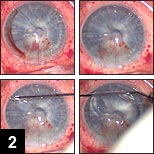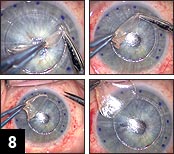Advanced surgical technique: Two-stage anterior lamellar keratoplasty
One-month interval between first stage and second stage helps to stabilize and provide some firm attachment of the cut flap.
 |
Anterior lamellar keratoplasty is an under-utilized surgical procedure in the United States and worldwide. In contrast, posterior lamellar keratoplasty such as descemetorhexis with endokeratoplasty/Descemet’s stripping with automated endothelial keratoplasty has gained rapid acceptance among corneal surgeons in the United States, and the favorable advantages of this procedure over the conventional, full-thickness, penetrating keratoplasty has partially contributed to the increasing numbers of corneal transplantations being performed.

It is conceivable that as corneal surgeons get more comfortable performing endokeratoplasty/Descemet’s stripping with automated endothelial keratoplasty, the next natural surgical progression would be anterior lamellar keratoplasty (ALK). There are different types of ALK procedures, depending on the depth of host corneal tissue that is excised and replaced with a matching thickness donor corneal disc. John-Malbran classification divides ALK into SALK (superficial ALK), MALK (mid ALK), DALK (deep ALK) and TALK (total ALK), depending on the depth of corneal excision.
This article presents the advanced surgical technique of performing an automated ALK using a microkeratome as a two-stage procedure.
Stage 1 ALK
I routinely use topical anesthesia with monitored anesthesia care for the procedure. However, peribulbar, retrobulbar or general anesthesia may be considered.
 Anterior corneal (upper left) scar, neovascularization, s/p laser treatment of corneal neovascularization; (Upper right) Suction ring is placed in position; (Lower left) – Moria microkeratome is used to create an anterior flap that captures the entire anterior corneal scar; (Lower right) The flap is replaced. |  After the creation of the corneal flap that fully encompasses the corneal scar, the interface is rinsed thoroughly with sterile balanced salt solution and the flap is replaced. | |
Images: John T | ||
 A Lindstrom roller (upper row) is used to smoothen the anterior flap and to attain proper seating of the flap on the corneal bed; (Bottom row) An interrupted 10-0 nylon suture is placed at 6 o’clock to firmly attach the flap. |  Two additional 10-0 nylon sutures are placed at 3 o’clock and 9 o’clock positions, and a bandage soft contact lens is placed over the cornea. | |
Using a Moria microkeratome, the host cornea is cut to appropriate thickness (Figure 1), depending on the depth of involvement by the scar or other pathology involving the host anterior cornea. The interface is rinsed well using sterile balanced salt solution, and the flap is replaced (Figure 2). A Lindstrom roller is used on the surface of the cut corneal flap to express out any interface pockets of fluid and to make the flap interface smooth and uniform (Figure 3). A few interrupted 10-0 nylon sutures are placed on the flap edge to further enhance the seating and attachment of the cut flap (Figure 4). A bandage soft contact lens on the corneal surface completes the first stage of this ALK procedure (Figure 4).
After the completion of the first stage of the ALK procedure, it is advisable to wait about 1 month before proceeding to the second stage of the ALK procedure. This interval helps to stabilize and provide some firm attachment of the cut flap to the host corneal stromal bed. This attachment of the flap to the corneal bed will usually facilitate the second stage of the procedure. It is important to attain proper centration of the trephine.
 The donor cornea (upper left) is mounted within a Moria artificial anterior chamber; (Upper right) A Moria microkeratome is used on the donor cornea to create a free cap of appropriate thickness; (Bottom left) Free cap is seen within the head of the microkeratome; (Bottom right) The donor corneal disc is then gently removed from the microkeratome head. |  View of the cornea (upper left) 1 month after stage 1 anterior lamellar keratoplasty; (Upper right) A sterile marking pen is used to place multiple dots along the previously created flap edge; (Bottom row) A surgical caliper is used to determine the appropriate diameter of the trephine to be used, such that the trephination can be performed inside the flap edge. |  The host cornea (upper left) is trephined using a Hanna trephine. The trephination matches the depth of the flap that was previously created; (Upper right) View of the completed trephination; (Bottom row) The central host disc of corneal tissue is then gently peeled off from the patient’s cornea. | |
 Progressive peeling of the host corneal disc of tissue. Any strands of circumferential attachment are severed using Vannas scissors. |  Component 1 (upper row) of the fibrin glue is applied to the host corneal bed; (Lower row) Component 2 of the fibrin glue is applied to the stromal surface of the donor corneal disc. |  Donor corneal disc (upper row) is then placed on the host corneal bed and firmly attached with the fibrin glue in the interface; (Bottom left) Notice that the donor corneal disc is well-centered within the previously cut host corneal flap. A few interrupted 10-0 nylon sutures are placed for additional secure attachment of the donor corneal disc to the recipient cornea; (Bottom left) A bandage soft contact lens is placed on the corneal surface. | |
Images: John T | |||
Stage 2 ALK
Optisol-GS solution (Bausch & Lomb) provided by the eye bank is first used to fill the well within the artificial anterior chamber (Moria) via a syringe attached to the artificial anterior chamber containing the solution (See ‘Cut-and-paste’ sutureless ALK minimizes risk of corneal stromal melt,” Ocular Sugery News, April 10, 2008). The donor cornea is next encased within the artificial anterior chamber (Figure 5) without the use of any viscoelastic material because the donor endothelium is not used for the procedure. In countries outside of the United States, one cornea may be used for three patients, namely, the anterior portion for an ALK and the posterior part of the donor cornea with a healthy corneal endothelium for a posterior lamellar keratoplasty, such as descemetorhexis with endokeratoplasty/Descemet’s stripping with automated endothelial keratoplasty procedure, and the rim for stem cell transplantation. The artificial anterior chamber is then pressurized. Using a microkeratome (Moria), a donor corneal cap is cut (Figure 5). The thickness of the free-cap of the donor cornea matches the thickness of the flap that was initially created on the patient’s cornea as the first-stage ALK procedure (eg, host flap created to 170 µm thickness to fully include the corneal scar in the first-stage ALK procedure, then the donor cornea is cut to the same depth, namely, 170-µm during the second-stage ALK procedure). The free cap remains on the microkeratome head (Figure 5). This donor corneal disc is removed from the microkeratome head (Figure 5), and it is placed in Optisol-GS solution, and attention is directed to the patient’s cornea.
Host cornea
The view of the patient’s cornea 1 month after the first-stage ALK is seen in Figure 6. To facilitate the viewing of the flap edge on the patient’s cornea, multiple dots are placed using a sterile marking pen (Figure 6). Next, a surgical caliper is used to determine the appropriate size of the trephine to be used on the patient’s cornea during the second-stage ALK (Figure 6). A Hanna trephine is centered over the host cornea, suction is applied, and trephination is carried out to a depth slightly greater than the initial cut during the first-stage ALK (Figure 7). After completion of the trephination (Figure 7), the host corneal disc with the corneal scar is progressively peeled-off from the patient’s cornea, leaving a host corneal bed that is now devoid of the scar tissue (Figures 7 and 8).
The donor free-cap is then trephined using the same diameter trephine that was used on the patient’s cornea.
The host stromal bed and the stromal surface of the donor corneal disc are thoroughly rinsed using sterile balanced salt solution. Component 1 is applied to the host stromal bed, and component 2 of the fibrin glue is applied to the stromal surface of the donor corneal disc (Figure 9). The donor disc is firmly attached to the host corneal bed using the fibrin glue and a few interrupted 10-0 nylon sutures (Figure 10). A bandage soft contact lens is applied to the corneal surface at the end of the procedure (Figure 10).
Surgical pearls and tips
- Determine preoperatively the corneal depth from the epithelial surface that will fully encompass the corneal scar or any other superficial pathology that is being treated with this procedure. This can be achieved using various preoperative tests such as optical coherence tomography, confocal microscopy, etc. Improper choice of the microkeratome head can result in residual scar being left behind on the patient’s stromal bed.
- During the first-stage ALK, reflect the cut corneal flap and confirm that the scar tissue is well within the flap and that the bed is devoid of any scar tissue.
- During the second-stage ALK procedure, use the same depth microkeratome head on the donor cornea as the one that was used on the patient’s cornea during the first-stage ALK.
- Enter the proper plane to easily peel off the cut corneal disc on the patient’s cornea during stage-two ALK procedure.
- Confirm the host stromal bed is devoid of any corneal scar tissue.
- Request the eye bank to provide a donor cornea with a large sclera rim (3.6 mm to 4 mm) to prevent donor disc slippage within the artificial anterior chamber.
- Avoid eccentric trephination on the host and donor corneal cap by proper centration.
- Apply the fibrin glue separately as component 1 and 2 and not simultaneously as provided by the manufacturer in a dual syringe set-up.
- Apply uniform pressure on the donor corneal disc to obtain optimal, uniform adherence of the donor corneal disc to the patient’s corneal stromal bed.
Treatment
Preoperatively, a prophylactic antibiotic, either Iquix (levofloxacin 1.5%, Vistakon), Vigamox (moxifloxacin 0.5%, Alcon) or Zymar (gatifloxacin 0.3%, Allergan) is used. Postoperatively, a topical steroid, Pred Forte 1% (prednisolone acetate 1%, Allergan), and an antibiotic levofloxacin 1.5%, moxifloxacin 0.5% or gatifloxacin 0.3% are used four times a day. For globe protection, the patient is asked to wear glasses or an eye shield during the day and a shield at night for the operative eye.
For more information:
- Thomas John, MD is a clinical associate professor at Loyola University at Chicago and is in private practice in Tinley Park and Oak Lawn, Ill. He can be reached at 708-429-2223; fax: 708-429-2226; e-mail: tjcornea@gmail.com. Dr. John has no direct financial interest in the products discussed in this article. He is a paid consultant to Vistakon and is a speaker for Vistakon, Allergan and Alcon.
References:
- John T. Surgical Techniques in Anterior and Posterior Lamellar Corneal Surgery. New Delhi, India: Jaypee Brothers Medical Publishers; 2006.
- John T. Step by Step Anterior and Posterior Lamellar Keratoplasty. New Delhi, India: Jaypee Brothers Medical Publishers; 2006.
